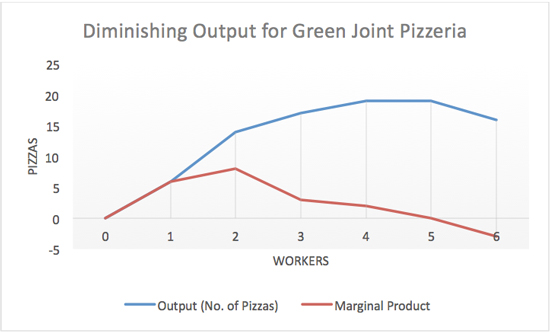 What is Diminishing Marginal Product?
What is Diminishing Marginal Product?
Definition: Diminishing marginal product is an economic concept that describes the phenomenon where the more input that is employed in a production process the lesser the margin of extra output obtained. This concept helps managers to refine their decisions concerning how to adjust inputs in a way that maximizes productivity.
The primary goal of a business is to maximize profits. Whatever decision the manager makes, it should be gainful in terms of creating or increasing profits. Usually, the manager has to decide on what should be done to increase productivity. One of the solutions available is to increase the size of one input while the others stay unchanged. However, soon the manager will realize that more of the input produces insignificant change in the output. This article explains this phenomenon.
The marginal product of an input is high during the initial stages. For example, if you open a pizzeria but without employees, there will be zero pizzas produced. When you hire one worker, he/she may be able produce six pizzas per day. Therefore, the marginal product of the worker is six. When you add one more worker, they may produce 14 pizzas per day. Adding another worker to make them three may bring the pizzas made per day to 17. What if you added a fourth worker and the pizzas produced increase to 19 but stay at 19 when you add a fourth one?
From the example, it is clear that the margin of extra pizzas produced begin to fall from the third worker. This happens although the total productivity of the pizzeria is increasing. What happened? It could be that as the workers increased, the space in the kitchen became smaller. As such, the productivity of each worker fell because they started getting in each other’s way.
How to Calculate Diminishing Marginal Product
It is crucial for managers and business owners to understand the concept of diminishing marginal product. This is because it helps them to better optimize the productivity of inputs. With this information, a business manager will make better decisions concerning the size of inputs to increase for the business to hit optimum production levels. However, one must learn how to calculate the diminishing marginal product of the input for better understanding.
Let us revisit the example of the pizzeria cited above. For convenience sake, we shall name the business as Green Joint Pizzeria. Green Joint Pizzeria opens for business but with a single worker. The worker produces six pizzas in a day. However, the business owner decides to add workers to increase productivity. The table below shows the schedule of hired workers and the input.
| Input (No. of workers) | Output (No. of Pizzas) | Marginal Product |
| 0 | 0 | – |
| 1 | 6 | 6 |
| 2 | 14 | 8 |
| 3 | 17 | 3 |
| 4 | 19 | 2 |
| 5 | 19 | 0 |
| 6 | 16 | -3 |
From the table, we can see that marginal product began to diminish from the third worker until it became negative by the sixth worker. On the other hand, total output began to stagnate at the fifth worker and fell at the sixth worker.
Diminishing Marginal Product Example Graph

From the data in the table, we can use excel to represent the concept of diminishing marginal product formula. Clearly, the productivity of Green Joint Pizzeria begins to falter after the coming of the third worker.
The chart represents a very crucial concept that is central to economic. This is the law of diminishing marginal productivity. The law states that the marginal increase in productivity that arises from utilizing an extra unit of input tapers off until it is negative. Once the marginal productivity becomes negative, the business begins to generate losses and managers or business owners must consider adjusting another input. In Green Joint Pizzeria’s case, the business owner might consider building a new kitchen that is spacious. This way, workers will have ample working space hence increasing their productivity.
